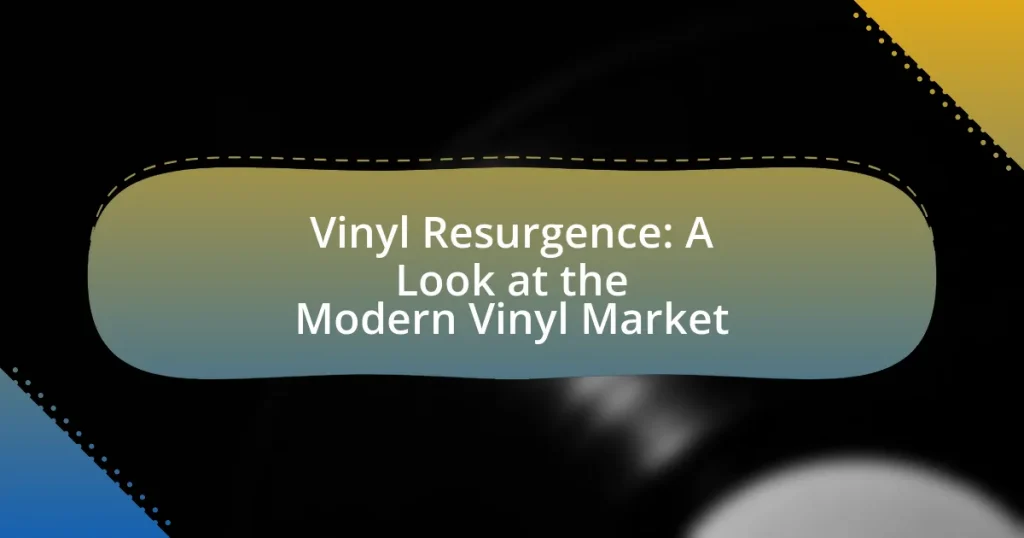Iconic album covers are significant visual representations that accompany music albums, often reflecting the themes and emotions of the music while contributing to the artists’ branding. This article explores the elements that contribute to the iconic status of album covers, such as visual artistry, cultural relevance, and historical context. It examines how album covers reflect the music and artists they represent, highlights notable examples like The Beatles’ “Sgt. Pepper’s Lonely Hearts Club Band” and Pink Floyd’s “The Dark Side of the Moon,” and discusses the processes involved in their creation. Additionally, the article delves into the stories behind these covers, the influence of societal changes on design, and the lessons that artists and designers can learn from these iconic visuals.
![]()
What are Iconic Album Covers?
Iconic album covers are visually striking and culturally significant artworks that accompany music albums, often becoming symbols of the music they represent. These covers frequently reflect the themes, emotions, or artistic vision of the album, making them memorable and influential in popular culture. For example, the cover of The Beatles’ “Sgt. Pepper’s Lonely Hearts Club Band” is renowned for its vibrant colors and collage of famous figures, which has made it a lasting icon in music history. Such covers not only enhance the listener’s experience but also contribute to the branding and identity of the artists, solidifying their place in the music industry.
Why do album covers hold significance in music culture?
Album covers hold significance in music culture because they serve as visual representations of the music and the artist’s identity. These covers often encapsulate the themes, emotions, and messages conveyed in the album, creating a deeper connection between the listener and the music. For instance, iconic album covers like The Beatles’ “Sgt. Pepper’s Lonely Hearts Club Band” not only reflect the psychedelic era of the 1960s but also influence fashion and art, demonstrating the cultural impact of music. Additionally, album covers can become symbols of movements or genres, such as Nirvana’s “Nevermind,” which represents the grunge movement of the early 1990s. This visual aspect enhances the overall experience of music consumption, making album covers a crucial element in the music industry.
What elements contribute to the iconic status of an album cover?
The elements that contribute to the iconic status of an album cover include visual artistry, cultural relevance, and historical context. Visual artistry, such as unique design and striking imagery, captures attention and creates a memorable aesthetic, exemplified by The Beatles’ “Sgt. Pepper’s Lonely Hearts Club Band,” which features vibrant colors and intricate details. Cultural relevance ensures that the cover resonates with the societal themes of its time, as seen in Nirvana’s “Nevermind,” which reflects the disillusionment of the early 1990s. Historical context, including the impact of the album on music and society, further solidifies its iconic status; for instance, Pink Floyd’s “The Dark Side of the Moon” is not only visually striking but also represents a significant shift in rock music and album production. These elements combined create a lasting impression that elevates an album cover to iconic status.
How do album covers reflect the music and artists they represent?
Album covers reflect the music and artists they represent by visually encapsulating the themes, emotions, and cultural contexts of the work. For instance, the cover of Pink Floyd’s “The Dark Side of the Moon” uses a prism to symbolize the spectrum of human experience, aligning with the album’s exploration of mental health and existential themes. Similarly, Nirvana’s “Nevermind” cover, featuring a baby swimming towards a dollar bill, critiques consumerism and innocence, mirroring the band’s grunge ethos. These visual representations serve as a bridge between the auditory experience and the artist’s identity, often becoming iconic symbols that enhance the listener’s understanding and connection to the music.
What are some examples of iconic album covers?
Some examples of iconic album covers include “The Beatles’ Sgt. Pepper’s Lonely Hearts Club Band,” which features a colorful collage of famous figures and was designed by Peter Blake and Jann Haworth in 1967. Another example is Pink Floyd’s “The Dark Side of the Moon,” known for its simple yet striking prism design created by Storm Thorgerson in 1973. Additionally, Nirvana’s “Nevermind,” featuring a baby swimming towards a dollar bill, was photographed by Kirk Weddle in 1991 and has become emblematic of the grunge era. These covers are recognized not only for their artistic merit but also for their cultural impact, influencing music and visual art.
Which album covers are considered the most influential?
The most influential album covers include “The Beatles’ Sgt. Pepper’s Lonely Hearts Club Band,” “Pink Floyd’s The Dark Side of the Moon,” and “Nirvana’s Nevermind.” “Sgt. Pepper’s” is renowned for its vibrant colors and collage of famous figures, which set a new standard for artistic expression in music. “The Dark Side of the Moon” features a simple yet iconic prism design that symbolizes the band’s exploration of complex themes, becoming one of the best-selling albums of all time. “Nevermind” is notable for its provocative imagery of a baby swimming towards a dollar bill, which captured the essence of the grunge movement and resonated with a generation. These covers not only defined their respective albums but also influenced the visual language of music marketing and art.
How have different genres influenced album cover design?
Different music genres have significantly influenced album cover design by dictating visual styles, themes, and artistic choices. For instance, rock music often features bold, rebellious imagery and vibrant colors, as seen in iconic covers like The Rolling Stones’ “Sticky Fingers,” which utilized provocative visuals to reflect the genre’s countercultural ethos. In contrast, jazz album covers frequently emphasize minimalist design and sophisticated typography, exemplified by Blue Note Records’ use of striking photography and clean layouts to convey a sense of elegance and artistry. Additionally, hip-hop album covers often incorporate urban aesthetics and graphic design elements, as demonstrated by Nas’s “Illmatic,” which uses street photography to connect with its cultural roots. These genre-specific characteristics not only enhance the visual appeal of the albums but also serve to communicate the underlying themes and messages of the music itself.
![]()
How are Iconic Album Covers Created?
Iconic album covers are created through a combination of artistic vision, collaboration, and cultural context. Designers, photographers, and artists work closely with musicians to capture the essence of the music and the artist’s identity, often drawing inspiration from various art movements, personal experiences, and societal themes. For instance, the cover of Pink Floyd’s “The Dark Side of the Moon,” designed by Storm Thorgerson, utilized a simple yet powerful prism design to symbolize the album’s exploration of complex themes like mental health and the human experience. This collaboration and thoughtful design process contribute to the lasting impact and recognition of iconic album covers in music history.
What processes are involved in designing an album cover?
Designing an album cover involves several key processes, including concept development, visual research, design execution, and final production. Initially, concept development entails brainstorming ideas that reflect the music’s themes and the artist’s identity. Visual research follows, where designers gather inspiration from various sources, such as art, photography, and cultural references, to inform their design choices.
Next, design execution involves creating the layout, selecting typography, and incorporating imagery that aligns with the established concept. This stage often includes multiple iterations and feedback from the artist or record label to refine the design. Finally, the production process ensures that the cover is printed or digitally formatted correctly, adhering to industry standards for quality and resolution.
These processes are essential for creating an impactful album cover that resonates with audiences and enhances the overall music experience.
Who are the key players in the album cover creation process?
The key players in the album cover creation process include graphic designers, photographers, art directors, and musicians. Graphic designers are responsible for the visual layout and overall aesthetic of the cover, while photographers capture the images that may be used. Art directors oversee the creative direction and ensure that the visual elements align with the artist’s vision. Musicians provide input on the concept and themes, influencing the design to reflect their artistic identity. Each of these roles is crucial in producing a cohesive and impactful album cover that resonates with audiences.
What role does the artist play in the design of their album cover?
The artist plays a crucial role in the design of their album cover by influencing its visual representation to align with their musical identity and thematic concepts. This involvement often includes collaborating with graphic designers and visual artists to ensure that the imagery reflects the album’s mood, message, and overall aesthetic. For instance, iconic album covers like Pink Floyd’s “The Dark Side of the Moon” were directly shaped by the band’s vision, which sought to convey complex themes through striking visuals. This synergy between music and art not only enhances the listener’s experience but also solidifies the artist’s brand and artistic narrative in the music industry.
What artistic styles are commonly used in album cover design?
Album cover design commonly utilizes artistic styles such as minimalism, surrealism, pop art, and abstract expressionism. Minimalism focuses on simplicity and clean lines, often using limited color palettes to convey a strong visual message. Surrealism incorporates dream-like imagery and unexpected juxtapositions, creating a sense of intrigue and emotional depth. Pop art draws inspiration from popular culture and mass media, often featuring bold colors and graphic elements that resonate with contemporary audiences. Abstract expressionism emphasizes spontaneous and expressive forms, allowing for a personal interpretation of the music. These styles have been employed by various artists and bands to visually represent their music and connect with their audience, making album covers an essential aspect of the music industry.
How do visual trends impact the design of album covers?
Visual trends significantly influence the design of album covers by dictating aesthetic choices that resonate with contemporary audiences. Designers often adopt popular styles, color palettes, and graphic elements to ensure that album covers are visually appealing and relevant. For instance, the rise of minimalism in the 2010s led to many artists opting for simple, clean designs that emphasize typography and negative space, reflecting broader cultural shifts towards simplicity and clarity. Additionally, the use of digital art and photography has evolved with technology, allowing for innovative designs that capture attention in a crowded market. This alignment with visual trends not only enhances marketability but also helps convey the artist’s identity and message effectively.
What techniques do designers use to convey themes through album art?
Designers use various techniques to convey themes through album art, including color symbolism, imagery, typography, and composition. Color symbolism allows designers to evoke specific emotions; for instance, warm colors can suggest energy or passion, while cool colors may convey calmness or sadness. Imagery, such as photographs or illustrations, can directly represent the album’s themes or concepts, creating a visual narrative that resonates with the music. Typography plays a crucial role in setting the tone; the choice of font style can reflect the genre or mood of the album. Additionally, composition techniques, such as balance and focal points, guide the viewer’s eye and emphasize key elements, enhancing the overall message. These methods are supported by historical examples, such as Pink Floyd’s “The Dark Side of the Moon,” where the prism cover art symbolizes the spectrum of human experience, effectively aligning with the album’s themes of life and mental health.
![]()
What Stories Lie Behind Iconic Album Covers?
Iconic album covers often tell compelling stories that reflect the music, the artists, and the cultural context of their time. For example, the cover of The Beatles’ “Sgt. Pepper’s Lonely Hearts Club Band” features a collage of famous figures, symbolizing the band’s influence and the psychedelic era of the 1960s. This artwork was created by Peter Blake and Jann Haworth, who aimed to capture the spirit of the times and the band’s artistic evolution. Similarly, Pink Floyd’s “The Dark Side of the Moon” cover, designed by Storm Thorgerson, uses a prism to represent the band’s exploration of complex themes such as mental health and the human experience, resonating with the album’s lyrical content. These covers serve not only as visual representations of the music but also as cultural artifacts that encapsulate the narratives and emotions of their respective eras.
What are some fascinating stories behind famous album covers?
Fascinating stories behind famous album covers include the iconic “Abbey Road” by The Beatles, which features the band crossing a street in London, symbolizing their unity and the end of an era. The cover was shot on August 8, 1969, and has since become a cultural landmark, often interpreted as a metaphor for the band’s breakup. Another notable example is Pink Floyd’s “The Dark Side of the Moon,” which features a prism dispersing light, designed by Storm Thorgerson. This imagery represents the band’s exploration of complex themes like mental health and the passage of time, and it has become one of the most recognizable album covers in history. Additionally, the cover of Nirvana’s “Nevermind,” depicting a baby swimming towards a dollar bill, was conceived by art director Robert Fisher and symbolizes the innocence lost in the pursuit of materialism, reflecting the band’s critique of consumer culture. Each of these covers not only visually represents the music but also encapsulates deeper meanings and cultural commentary, making them iconic in the music industry.
How do personal experiences of artists influence their album cover designs?
Personal experiences of artists significantly influence their album cover designs by reflecting their emotions, cultural backgrounds, and life events. For instance, an artist’s struggles with mental health may lead to darker, more abstract visuals, while joyous milestones can inspire vibrant and celebratory imagery. A notable example is the album cover for “The Dark Side of the Moon” by Pink Floyd, which symbolizes the band’s exploration of mental health issues and existential themes, directly stemming from their personal experiences. This connection between an artist’s life and their visual representation on album covers creates a deeper narrative that resonates with listeners, making the artwork an integral part of the music’s storytelling.
What controversies have arisen from iconic album covers?
Controversies surrounding iconic album covers often stem from their provocative imagery or themes. For example, the cover of The Beatles’ “Yesterday and Today” featured the band surrounded by dismembered baby dolls and raw meat, which led to public outrage and its subsequent recall in 1966. Similarly, the cover of Nirvana’s “Nevermind,” depicting a naked baby swimming towards a dollar bill, sparked debates about child exploitation and nudity in art. Additionally, the Rolling Stones’ “Sticky Fingers” cover, which included a working zipper, faced criticism for its sexual implications. These instances illustrate how album covers can provoke strong reactions and discussions about societal norms and artistic expression.
How do cultural and historical contexts shape album cover art?
Cultural and historical contexts significantly shape album cover art by influencing the themes, imagery, and design choices that reflect societal values and events. For instance, during the 1960s, the counterculture movement and civil rights struggles inspired album covers that featured psychedelic art and social commentary, as seen in The Beatles’ “Sgt. Pepper’s Lonely Hearts Club Band,” which incorporated vibrant colors and cultural icons to reflect the era’s spirit. Additionally, the rise of hip-hop in the 1980s and 1990s led to album covers that showcased urban culture and personal narratives, exemplified by Nas’s “Illmatic,” which used a photograph of a New York City street to convey authenticity and connection to the artist’s roots. These examples illustrate how album cover art serves as a visual representation of the cultural and historical moments in which they were created, making them integral to understanding the music and its impact.
What historical events have influenced the imagery on album covers?
Historical events such as the Vietnam War, the Civil Rights Movement, and the rise of counterculture in the 1960s significantly influenced the imagery on album covers. For instance, the anti-war sentiment during the Vietnam War led to iconic covers like “Peace” by the Beatles, which reflected the desire for peace and social change. Similarly, the Civil Rights Movement inspired artists like Marvin Gaye, whose album “What’s Going On” featured imagery that addressed social justice and equality. The counterculture movement also brought psychedelic art to the forefront, as seen in the cover of “Sgt. Pepper’s Lonely Hearts Club Band,” which embodied the spirit of experimentation and rebellion of the era. These events shaped not only the music but also the visual representation of the albums, making them powerful cultural artifacts.
How do societal changes reflect in the evolution of album cover designs?
Societal changes significantly influence the evolution of album cover designs by mirroring cultural, political, and technological shifts. For instance, during the 1960s, the rise of counterculture and social movements led to vibrant, psychedelic artwork that reflected the era’s rebellion against traditional norms. The introduction of digital technology in the 1990s shifted album cover designs towards minimalism and digital art, as seen in the works of artists like Radiohead, whose album “Kid A” featured abstract imagery that resonated with the digital age’s complexities. Furthermore, contemporary issues such as climate change and social justice are now often depicted in album art, as artists use their covers to make statements about current events, exemplified by Billie Eilish’s “When We All Fall Asleep, Where Do We Go?” which addresses mental health and environmental concerns. These examples illustrate how album cover designs evolve in response to the changing societal landscape, serving as a visual commentary on the times.
What can we learn from the stories behind iconic album covers?
The stories behind iconic album covers reveal insights into the cultural, artistic, and personal contexts of the music they represent. These narratives often reflect the social issues, artistic movements, and personal experiences of the artists, providing a deeper understanding of the music’s themes. For instance, the cover of The Beatles’ “Sgt. Pepper’s Lonely Hearts Club Band” showcases a collage of influential figures, symbolizing the band’s connection to the counterculture of the 1960s. This connection illustrates how album art can serve as a visual commentary on societal changes. Additionally, the cover of Pink Floyd’s “The Dark Side of the Moon” uses simple yet powerful imagery to convey complex themes of mental health and existentialism, enhancing the listener’s experience. Thus, analyzing these stories enriches our appreciation of both the music and the cultural landscape of the time.
How can understanding album cover stories enhance our appreciation of music?
Understanding album cover stories enhances our appreciation of music by providing context and deeper meaning to the auditory experience. Album covers often reflect the themes, emotions, and artistic intentions of the music, allowing listeners to connect more profoundly with the content. For instance, the cover of Pink Floyd’s “The Dark Side of the Moon” symbolizes the complexities of life and mental health, which aligns with the album’s lyrical exploration of these themes. This connection between visual art and music can lead to a richer, more immersive listening experience, as it encourages listeners to engage with the narrative and emotional layers present in the music.
What tips can artists and designers take from iconic album cover stories?
Artists and designers can take several tips from iconic album cover stories, primarily focusing on storytelling, visual impact, and cultural relevance. Storytelling is crucial; for instance, the cover of Pink Floyd’s “The Dark Side of the Moon” uses a prism to symbolize the band’s exploration of complex themes, demonstrating how a single image can convey deep narratives. Visual impact is also essential; the bold colors and striking imagery of The Beatles’ “Sgt. Pepper’s Lonely Hearts Club Band” create an unforgettable aesthetic that captures attention. Additionally, cultural relevance plays a significant role; covers like Nirvana’s “Nevermind” reflect societal issues, showing that connecting with the audience’s context can enhance the artwork’s significance. These elements combined illustrate how effective album covers can inspire artists and designers to create meaningful and impactful visual works.














